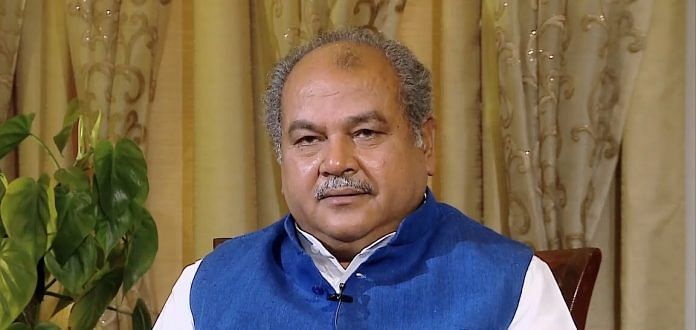Rural development minister Narendra Tomar in interview to ThePrint says the focal point of all of PM Modi’s schemes are the poor.
New Delhi: The Modi government’s decision to significantly hike the minimum support price (MSP) for the Kharif crop is being seen as part of the Bharatiya Janata Party’s efforts to build a pro-rural and welfare-oriented plank ahead of the 2019 Lok Sabha elections.
But the man tasked with overseeing the party’s game plan to a significant extent — Rural Development Minister Narendra Singh Tomar — said while welfare initiatives should not be seen from the point of view of elections, his government does believe that if it does “good work” it will benefit electorally.
“It is not right to connect these schemes to elections. Whether our schemes and programmes will bring us votes is not what the BJP worries about. The focal point of all PM Modi’s initiatives has been the poor,” Tomar told ThePrint in an exclusive interview.
“The government wants to correct the imbalance and disparity that exists. We want to uplift the poor, deprived and underprivileged sections. Thus, it is wrong to look at policies as being related to elections. But it is also true that if we do good work, people will like and appreciate us, which in turn will help us. That expectation on our part is natural,” Tomar said.
At the heart of the NDA government’s plans are some key schemes that fall under Tomar’s ministry such as the Pradhan Mantri Awaas Yojana (PMAY), which is the rural housing scheme; the rural roads programme, the Pradhan Mantri Gram Sadak Yojana (PMGSY); the rural employment guarantee scheme, the Mahatma Gandhi National Rural Employment Act (MGNREGA) and the National Rural Livelihoods Mission (NRLM).
The latest addition is the Gram Swaraj Abhiyan, under which, the government has identified villages in aspirational districts in two phases so far to ensure saturation of seven key welfare schemes.
The rural development ministry has a budgetary allocation of Rs 1,14,915 crore, next only to the defence and railways ministries. Tomar, who has kept a low-profile, is the fourth rural development minister under this government and having taken charge in mid-2016, has had the longest run of the four.
Tomar was one of the ministers on whom PM Modi heaped praise in a recent interview to Swarajya magazine.
When asked about the “talent deficit” in his government, Modi had said, “This is an incorrect perception. Just because only a few ministers and ministries make it to the front pages or prime-time debates, they are deemed as talented and others are deemed the opposite. ..Let us talk about rural housing. This is not a sector that is connected to cities or the digital world. In the last four years, more than one crore houses have been built in rural areas. This is a big number. Crores of Indians who did not have a shelter over their head now have their own homes…This is the work done by someone many in the media will call non-talented.”
The NDA’s MGNREGA
While the key focus of Tomar’s ministry has been to ensure one crore houses are constructed in rural areas under PMAY by March 2019, just in time for the Lok Sabha elections, it has also made efforts to appropriate Congress-led UPA’s marquee MGNREGA.
The ministry said it has “ironed out several glitches with implementation”, including delayed wage payments, unproductive asset generation and lack of transparency. Ironically, when the BJP government came to power in 2014, it was accused of attempting to water-down the scheme, with Modi even referring to it as a “living monument of the UPAs failures” in Parliament.
With an eye on the electoral value of the scheme, however, the BJP soon changed track in an attempt to be seen like it was, in fact, improving and promoting the scheme.
Tomar said his government has given a “new form” to MGNREGA.
“We should not focus on what all was said about us when we came to power. We should not look at welfare programmes from a political lens. MGNREGA’s main agenda is to give people employment and our focus is to ensure its benefits reach as many people as possible. We have constantly increased the budget for the scheme. We have ensured wage payment delays are minimised,” he said.
“We want to focus not just on employment under it, but also asset creation and so we have also stressed on water conservation under it. That is what we have done, besides bringing in greater transparency in it. We have essentially presented MGNREGA in a new form,” he added.
SAGY a no-go
The biggest failure of the rural development ministry, however, has been its inability to find traction for PM Modi’s ‘model village scheme’, SAGY, an initiative that the PM himself envisaged and has been personally invested in. MPs have been reluctant to adopt villages under the scheme, citing its poor architecture and vision as well as the fact that it does not have separate funds allotted to it.
Tomar, however, blames the MPs for not having done enough and claims the idea behind the scheme is “not about additional money, but about additional work and additional vision.”
“Through SAGY, PM Modi made an open request to MPs to use their influence and power to help develop some gram panchayats. The idea is to ensure 100 per cent saturation of existing government schemes in the adopted villages. MPs have complained there are no additional funds allotted to it but that was never the idea. In the recent Gram Swaraj Abhiyan, we have managed to ensure saturation of seven welfare schemes in identified villages, without any additional funds. So if MPs really wanted to do it under SAGY, they could have,” he said.



